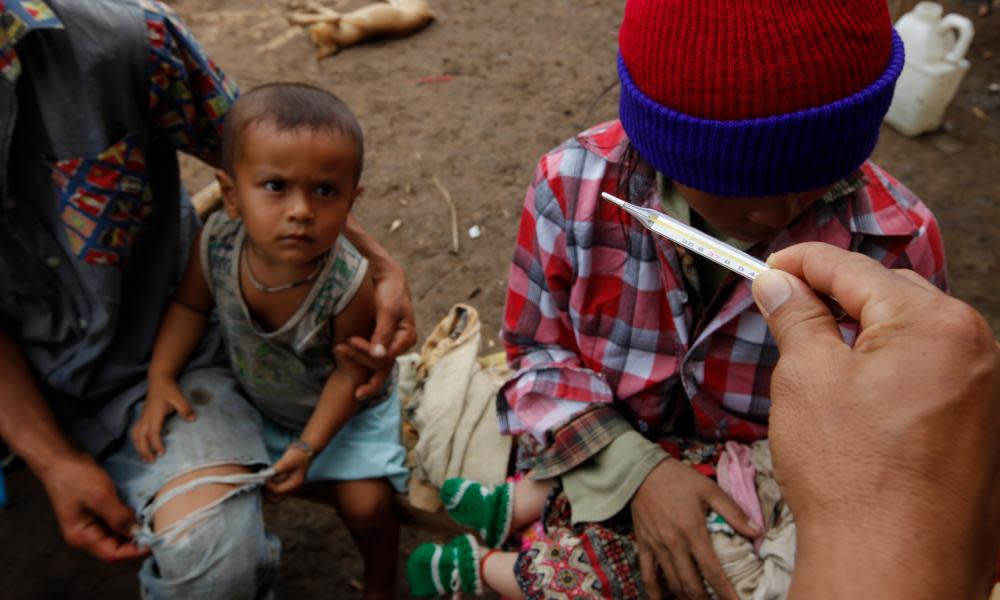'Unconscionable': 7,000 babies die daily despite record low for child mortality

The number of children who die before reaching their fifth birthday has fallen to an all-time low, yet children around the world continue to die at an alarming rate, with 5.6 million deaths recorded last year.
In its annual report on child mortality, the UN said many of the deaths – which averaged 15,000 a day in 2016 – were from preventable diseases.
The report also warned that neonatal mortality – the death of babies in the first 28 days of life – is not decreasing at the same pace as mortality rates for children aged between one month and five years. Each day, a total of 7,000 babies die before they are 28 days old.
The total number of deaths of children under five has dropped substantially in recent decades, falling from 12.6 million in 1990 to 5.6 million last year, down from 5.9 million in 2015.
The report estimates that 50 million children would have died between 2000 and 2016 had under-five mortality rates remained static since 2000.
“The good news is that the world has made remarkable progress in reducing child mortality since 1990,” said Danzen You, coordinator of the UN inter-agency group for the child mortality estimation, and one of the report’s authors. “The number of deaths now is the lowest in history. That reduction is really remarkable … Because of the investments we made in the last decades, we really accelerated progress in saving newborns and children.”
However, You warned that much remains to be done. Child mortality rates in many countries fall short of national commitments under the sustainable development goals, which call for the reduction of under-five mortality to a maximum of 25 deaths for every 1,000 live births by 2030. The figure currently stands at 41 deaths for every 1,000 live births.
The country with the highest rate of under-five mortality was Somalia, with 133 deaths for every 1,000 live births. The UK has an under-five mortality rate of four deaths for every 1,000 live births.
There were huge disparities across countries and regions. Sub-Saharan Africa has the highest under-five mortality rate, with 79 deaths for every 1,000 births, which translates to one child in 13 dying before their fifth birthday. This compares with six for every 1,000 in northern America and Europe and four for every 1,000 in Australia and New Zealand.
The same discrepancy is found when comparing mortality rates among babies. In sub-Saharan Africa, roughly one child in 36 dies in the first 28 days of life, while in high-income countries, the ratio is one in 333.
One million children each year die within 24 hours of being born, and close to 1 million die within the next six days of life.
Most deaths of newborns happened in southern Asia (39%) and sub-Saharan Africa (38%), with half of all newborn deaths happening in just five countries – India (24%), Pakistan (10%), Nigeria (9%), the Democratic Republic of the Congo (4%) and Ethiopia (3%).
While children in the older end of the under-five age bracket are particularly at risk of infectious diseases, which can be successfully treated by vaccines, improving neonatal care, which often involves training of midwives and overhauling health systems, has been trickier.
Pneumonia, diarrhoea and malaria accounted for almost one-third of deaths among under fives globally. Other leading causes of death among children under the age of five included pre-term birth complications and neonatal sepsis.
“It is unconscionable that in 2017, pregnancy and child birth are still life-threatening conditions for women, and that 7,000 newborns die daily,” said Tim Evans, senior director of health, nutrition and population at the World Bank Group. “The best measure of success for universal health coverage is that every mother should not only be able to access healthcare easily, but that it should be quality, affordable care that will ensure a healthy and productive life for her children and family.”

 Yahoo News
Yahoo News 
